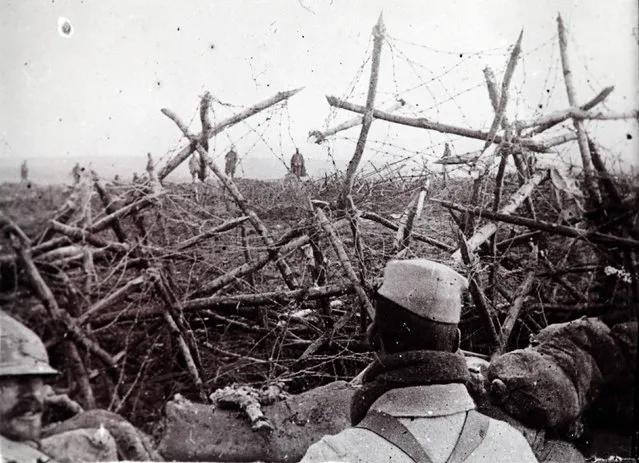
Colonel Guillot showing a bespectacled Chinese general the French guns during the Boxer rebellion, circa 1900. (Photo by Henry Guttmann/Getty Images)

This April 16, 1945 file photo provided by the U.S. Army, shows inmates of the German KZ Buchenwald inside their barrack, a few days after U.S troops liberated this concentration camp near Weimar. The young man seventh from left in the middle row bunk is Elie Wiesel, who would later become an author and Nobel Peace Prize laureate. (Photo by U.S. Army via AP Photo)

The German heavy cruiser Admiral Hipper abandoned in dry dock at Kiel, Germany, May 1945. (Photo by IWM/PA Wire)

German soldiers (rear) offer to surrender to French troops, as seen from a listening post in a trench at Massiges, northeastern France, in this undated archive picture. (Photo by Denise Follveider/Reuters/Collection Odette Carrez)

French cyclists of the Cavalry Corps, are seen on the Champagne Front, eastern France, in this September 22, 1915 archive file photo. (Photo by Denise Follveider/Reuters/Collection Odette Carrez)

Canadian soldiers land on Courseulles beach in Normandy, June 6, 1944 as Allied forces storm the Normandy beaches on D-Day. (Photo by Getty Images)

A group of British soldiers watch a cameraman filming the explosion of a bridge on Salisbury Plain, specially built to be blown up for a film about a battle between British troops and Chinese bandits, 15th July 1936. (Photo by Becker/Fox Photos/Getty Images)

American soldier Captain Joseph Naviochion training Chinese troops in the art of machine gunnery at Kwangsi in China, circa 1941. (Photo by Keystone/Getty Images)

Just before the British left China, these gentlemen met up for a photo session, 25th September 1940. There is an American Marine, a British “Tommy”, a Chinese Policeman, a Japanese Policeman, an Indian Policeman and a regular British Policeman. They were all resident in the world's most international city, Shanghai. (Photo by Keystone/Getty Images)

A wounded orderly from the Royal Army Medical Corps on a Chinese wheelbarrow, Tsingtau, China, 1914. (Photo by Hulton Archive/Getty Images)

A British soldier standing near the North Station, Chapei (Chinese territory Shanghai) during the Sino-Japanese conflict, circa 1935. They named their dugouts and sandbag emplacements in a style reminiscent of the 1914-1918 war in France. (Photo by Hulton Archive/Getty Images)

Men of the Border Regiment holding the area near the settlement boundary, China, 1927. (Photo by Topical Press Agency/Getty Images)

The Royal Tank Corps Armoured Car Section patrols an area of Chinese unrest in the International Settlement in Shanghai, 9th June 1927. (Photo by Topical Press Agency/Getty Images)

A medical orderly treating the sick and wounded during the siege of Tsingtao in the First World War, 1914. (Photo by Hulton Archive/Getty Images)

Chinese General Yang Chich leaves the library complex after a tour, during his visit to the Royal Military Academy in London's Woolwich, 1st June 1934. (Photo by PNA Rota/Getty Images)

South Korean gunners load their 105mm Howitzer near the front during the Korean War as they fire in support of the First Korean Infantry Division on August 2, 1950. (Photo by AP Photo)

A group of Soviet Communist soldiers aim their rifles skyward at German planes as they lay on their backs in the Kharkov sector on August 18, 1942 during World War II. (Photo by AP Photo)

Japanese infantrymen advance with rifles and grenades, leaping over barbed wire and preceded by an artillery barrage, in the Peking sector in China on August 19, 1937 during the Second Sino Japanese War. Heavy casualties occurred on both sides, but Chinese losses outnumbered the Japanese five to one. (Photo by AP Photo)

French troops, advancing with Allied forces northward from the coast of southern France, use a picture of Adolf Hitler found in a captured Nazi headquarters to demonstrate what they would like to do to the Madman of Europe, August 24, 1944. (Photo by Sherman Montrose/AP Photo/Acme)

Danish mine experts unscrewing the last “horn” of a mine, December 6, 1939, one of many washed ashore on the south coast of the Danish coast from German mine fields in the sound. After the mine's “horns” have been removed the mines are harmless and can be transported to the naval base. (Photo by AP Photo)

Members of a Polish tank regiment line up in French tanks which they took with them to Britain, where they are aiding the tommies in Scotland, December 28, 1940. (Photo by AP Photo)

This is the destruction of Nanking, known as the rape of Nanking, following its capture by the Japanese Imperial Army's Invasion of China during the second Sino-Japanese War on December 29, 1937. (Photo by AP Photo)

In this in September 1950 file photo, United Nations troops fire from a barricade in Seoul, South Korea. The building at left carries portraits of Soviet leader Josef Stalin and North Korean leader Kim Il Sung. For nearly 70 years, the three generations of the Kim family have run North Korea with an absolute rule that tolerates no dissent. The ruling family has devoted much of the country's scarce resources to its military but has constantly feared Washington is intent on destroying the authoritarian government. (Photo by Max Desfor/AP Photo)

Men strip gear from a Pershing tank after overturning it to keep road clear during retreat of United Nations forces from North Korea on December 14, 1950. Tank's track had become dislodged. Later a demolition crew burned the machine. (Photo by AP Photo)

A German special anti-tank gun is ready to fire during the army maneuvers in Silesia, Poland, on September 22, 1928. (Photo by AP Photo)
15 Jan 2018 03:21:00,
post received
0 comments
